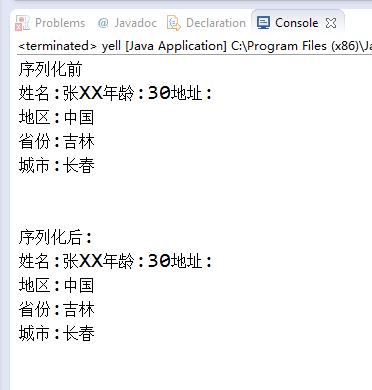通过序列化复制整个对象
Posted 寂寞的小丑
tags:
篇首语:本文由小常识网(cha138.com)小编为大家整理,主要介绍了通过序列化复制整个对象相关的知识,希望对你有一定的参考价值。
用到的所有的类都要实现Serializable接口
public class Address implements Serializable{ /** * */ private static final long serialVersionUID = 1L; private String state; private String province; private String city; public Address(String s,String p,String c){ this.state = s; this.province = p; this.city = c; } @Override public String toString() { StringBuilder sb = new StringBuilder(); sb.append("地区:"+state+"\\n"); sb.append("省份:"+province+"\\n"); sb.append("城市:"+city+"\\n"); return sb.toString(); } /** * @return the state */ public String getState() { return state; } /** * @param state the state to set */ public void setState(String state) { this.state = state; } /** * @return the province */ public String getProvince() { return province; } /** * @param province the province to set */ public void setProvince(String province) { this.province = province; } /** * @return the city */ public String getCity() { return city; } /** * @param city the city to set */ public void setCity(String city) { this.city = city; } }
public class Employee implements Serializable{ private String name; private int age; private Address address; public Employee(String n,int a,Address ad){ this.name = n; this.age = a; this.address = ad; } /** * @return the name */ public String getName() { return name; } /** * @param name the name to set */ public void setName(String name) { this.name = name; } /** * @return the age */ public int getAge() { return age; } /** * @param age the age to set */ public void setAge(int age) { this.age = age; } /** * @return the address */ public Address getAddress() { return address; } /** * @param address the address to set */ public void setAddress(Address address) { this.address = address; } /* (non-Javadoc) * @see java.lang.Object#toString() */ @Override public String toString() { StringBuilder sb = new StringBuilder(); sb.append("姓名:"+name); sb.append("年龄:"+age); sb.append("地址:"+"\\n"+address+"\\n"); return sb.toString(); } }
复制整个对象
public static void main(String[] args) { System.out.println("序列化前"); Address address = new Address("中国","吉林","长春"); Employee employee1 = new Employee("张XX",30,address); System.out.println(employee1); System.out.println("序列化后:"); ObjectOutputStream out = null; ObjectInputStream in = null; Employee employee2 = null; try { out = new ObjectOutputStream(new FileOutputStream("emploooo.dat")); out.writeObject(employee1); in = new ObjectInputStream(new FileInputStream("emploooo.dat")); employee2 = (Employee)in.readObject(); } catch (FileNotFoundException e) { e.printStackTrace(); }catch (IOException e) { e.printStackTrace(); }catch (ClassNotFoundException e) { e.printStackTrace(); }finally{ //toDo释放资源 } System.out.println(employee2); } }

以上是关于通过序列化复制整个对象的主要内容,如果未能解决你的问题,请参考以下文章